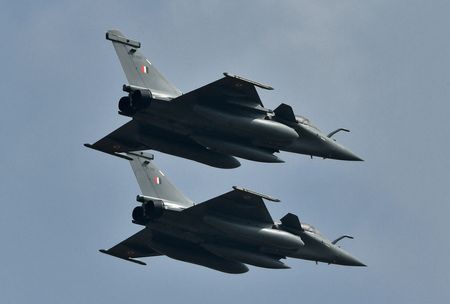By Greg Torode
HONG KONG (Reuters) – The conflict between India and Pakistan over Kashmir offers a potentially rich intelligence harvest for China in its own rivalry with India as it gleans data from its fighter jets and other weapons used in action by Pakistan.
Security analysts and diplomats say China’s military modernisation has reached a point where it has the ability to deeply scrutinise Indian actions in real time from its border installations and Indian Ocean fleets as well as from space.
“From an intelligence perspective, this is a rare target of opportunity right on China’s borders involving a key potential adversary,” said Singapore-based security analyst Alexander Neill.
Two U.S. officials said a Chinese-made J-10 Pakistani jet fighter shot down at least two Indian military planes – one of them a French-made Rafale fighter. India has not acknowledged the loss of any of its planes while Pakistan’s defence and foreign ministers have confirmed the use of J-10 aircraft but not commented on which missiles or other weapons were used.
The aerial clash is a rare opportunity for militaries around the world to study the performance of pilots, fighter jets and air-to-air missiles in active combat, and use that knowledge to prepare their own air forces for battle.
Competing regional giants and nuclear powers, India and China are widely seen as long-term strategic rivals, sharing a 3,800 (2,400 mile) Himalayan border that has been disputed since the 1950s and sparked a brief war in 1962.
The most recent standoff – that started in 2020 – thawed in October as the two sides struck a patrolling agreement.
Security analysts say both sides have taken steps to strengthen their military facilities and capabilities along the border, but it is also from above that China packs an intelligence gathering punch.
The London-based International Institute for Strategic Studies (IISS) notes that China now fields 267 satellites – including 115 devoted to intelligence, surveillance and reconnaissance and a further 81 that monitor military electronic and signals information. It is a network that dwarfs its regional rivals, including India, and is second only to the U.S..
“Both in terms of space and missile tracking capabilities, China is much better off now in terms of being able to monitor things as they happen,” said Neill, who is an adjunct fellow at Hawaii’s Pacific Forum think-tank.
China’s defence ministry did not immediately respond to Reuters’ questions about the deployment of its military satellites and other questions about its intelligence gathering.
Pakistan’s military media wing and information minister did not immediately respond to a request for comment on any information sharing with China.
Pakistan has previously said it has an “all-weather strategic, cooperative partnership” with China.
India has not commented on the issue, but its top diplomat in Britain, High Commissioner Vikram Doraiswami, told Sky News on Thursday that China’s relationship with Pakistan was not a concern for India.
“China requires a relationship with all of its neighbours, that includes us,” he said.
MISSILE DEPLOYMENTS
Chinese military intelligence teams would be eager to garner information on any Indian use of air defences and launches of cruise and ballistic missiles – not just in terms of flight paths and accuracy but command and control information, analysts and diplomats say.
Any deployment of India’s BrahMos supersonic cruise missile – a weapon it developed jointly with Russia – would be of particular interest, some analysts say, given they do not believe it has been used in combat.
China has also beefed up its intelligence gathering at sea. It has been increasingly active in the Indian Ocean in recent years, with China deploying space tracking ships as well as oceanographic research and fishing vessels on extended deployments, open source intelligence trackers say.
Regional diplomats say that while the Chinese navy has been relatively cautious about extensive warship deployments into the Indian Ocean, still lacking a broad network of bases, it actively seeks intelligence with these other vessels.
Over the last week, some trackers noted unusually large fleets of Chinese fishing vessels moving apparently in unison to within 120 nautical miles of Indian naval drills in the Arabian Sea as tensions rose with Pakistan.
Pentagon reports on China’s military modernisation and analysts note that China’s fishing fleets routinely perform a coordinated militia function that plays an important intelligence gathering role.
“These vessels may double up as listening posts, tracking development rhythms and response patterns, feeding early warning, naval intel to their sponsors,” wrote open source tracker Damien Symon in an X post that highlighted the deployment of 224 Chinese vessels near Indian naval exercises on May 1.
Chinese officials do not usually acknowledge the existence of fishing militia or intelligence work carried out by other nominally-civilian vessels.
Given its deep and broad strategic relationship with Pakistan, Beijing can also be expected to fully exploit its network of envoys and military teams there for key nuggets.
“The presence of Chinese military advisers and other personnel in Pakistan is well-known given how Pakistan’s Ministry of Defence has been importing some of its most advanced military hardware from China, so we can be certain the PLA would be able to access relevant data,” said James Char, a Chinese security scholar at Singapore’s S. Rajaratnam School of International Studies.
(Reporting by Greg Torode; additional reporting by Laurie Chen in Beijing, Charlotte Greenfield in Islamabad and Krishna Das in New Delhi; Editing by Raju Gopalakrishnan)










